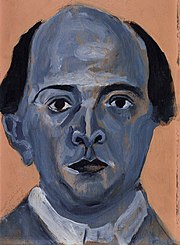
Sechs kleine Klavierstücke, Op. 19 (Six Little Piano Pieces) is a set of pieces for solo piano written by the Austrian composer Arnold Schoenberg, published in 1913 at Universal Edition in Vienna.
History
After having written large, dense works such as Pelleas und Melisande, up until 1907, Schönberg decided to turn away from this style, beginning with his second string quartet of 1908. The following excerpt, translated from a letter written to Ferruccio Busoni in 1909, well expresses his reaction against the excess of the Romantic period:
My goal: complete liberation from form and symbols, cohesion and logic. Away with motivic work! Away with harmony as the cement of my architecture! Harmony is expression and nothing more. Away with pathos! Away with 24 pound protracted scores! My music must be short. Lean! In two notes, not built, but "expressed". And the result is, I hope, without stylized and sterilized drawn-out sentiment. That is not how man feels; it is impossible to feel only one emotion. Man has many feelings, thousands at a time, and these feelings add up no more than apples and pears add up. Each goes its own way. This multicoloured, polymorphic, illogical nature of our feelings, and their associations, a rush of blood, reactions in our senses, in our nerves; I must have this in my music. It should be an expression of feeling, as if really were the feeling, full of unconscious connections, not some perception of "conscious logic". Now I have said it, and they may burn me.

This work was composed at the same time that Schoenberg was working on his orchestration of his massive Gurre-Lieder. While he maintained a lifelong love of Romantic music, the extreme contrast between his Klavierstücke and his more romantic works comes from his modernist desire to find a new means of expression. For him, works like the Gurre-Lieder or Verklärte Nacht fulfilled the tradition he loved, but it was works like these Klavierstücke, or the Fünf Orchesterstücke that attempted to reach beyond it.
The first five pieces were written in a single day, February 19, 1911, and were originally intended to comprise the entire piece. Schoenberg penned the sixth piece on June 17, shortly after the death of Gustav Mahler. Indeed, it is a, "well circulated claim that Schoenberg conceived op. 19/vi as a tombeau to Mahler". It was first performed on February 4, 1912, in Berlin, by Louis Closson.
The pieces have been arranged for a number of other instruments and ensembles. There is a guitar arrangement by Siegfried Behrend, and in 2006, Heinz Holliger arranged the pieces for instrumental ensemble, which he recorded with the Orchestre de Chambre de Lausanne.
Structure

Problems playing this file? See media help.
The six pieces do not carry individual names, but are often known by their tempo marking:
- Leicht, zart (Light, delicate)
- Langsam (Slow)
- Sehr langsame
 (Very slow
(Very slow  )
) - Rasch, aber leicht (Brisk, but light)
- Etwas rasch (Somewhat brisk)
- Sehr langsam (Very slow)
Each of the six pieces is aphoristically short, and unique in character. Following the expressionist aesthetic, each piece can be understood to be a long composition condensed into a single brief miniature. Schoenberg regarded this style of writing as a necessary compositional reaction to the diminishing power of tonality and this compositional style would be a huge influence on Schoenberg's pupil, Anton Webern, whose works are well known for their brevity. The work is commonly described as atonal, or at least any resemblance to tonality is fleeting, but it predates Schoenberg's later dodecaphonic development.
References
- Fearn, Raymond (2002). "Sechs kleine Klavierstücke op. 19". In Gerold W. Gruber (ed.). Arnold Schönberg. Interpretationen seiner Werke. Vol. 1. Laaber-Verlag. p. 269. ISBN 9783890075068.
- Arnold Schoenberg – Two Letters to Ferrucio Busoni, Liviu Marinescu course notes; cited from Ferrucio Busoni – Selected Letters, ed. and translated by Antony Beaumont, London: Faber & Faber 1987, pp. 389, 392–397
- Taruskin, Richard (2009). Music in the Early Twentieth Century, The Oxford History of Western Music 4 (New York: Oxford University Press), pp. 324–325. ISBN 0-19-538484-9. "the 'Eschbeg set', Schoenberg's musical signature." and "the 'A. Schbeg' (or 'Aschbeg') set."
- Klumpenhouwer, Henry (1994). "An Instance of Parapraxis in the Gavotte of Schoenberg's Opus 25", p. 246, Journal of Music Theory, Vol. 38, No. 2 (Autumn), pp. 217–248.
- "Arnold (Franz Walter) Schoenberg - 6 Kleine Klavierstucke, Op.19 (Guitar)". www.boosey.com. Retrieved 2022-10-07.
- "Heinz Holliger (1939): Arnold Schoenberg, Sechs kleine Klavierstücke op. 19 (1911) (2006)". IRCAM Database on Contemporary Music.
- "Debussy, Dukas, Roussel, etc review | Andrew Clements's classical album of the week". the Guardian. 2022-10-06. Retrieved 2022-10-07.
Further reading
- Schoenberg, Arnold. Sechs kleine Klavierstücke, Opus 19, score. Universal Edition. Vienna, 1913.
- Schoenberg, Arnold. Style and Idea. University of California Press, Los Angeles, 1984. ISBN 0-520-05294-3
External links
- 6 Little Piano Pieces: Scores at the International Music Score Library Project
- Sechs kleine Klavierstücke, audio and notes, Matthias Schmidt (in German), Arnold Schönberg Center, 28 June 2018
- Performance by Katherine Chi from the Isabella Stewart Gardner Museum in MP3 format
- The ND Music Edition of Schönberg's Sechs Kleine Klavierstücke